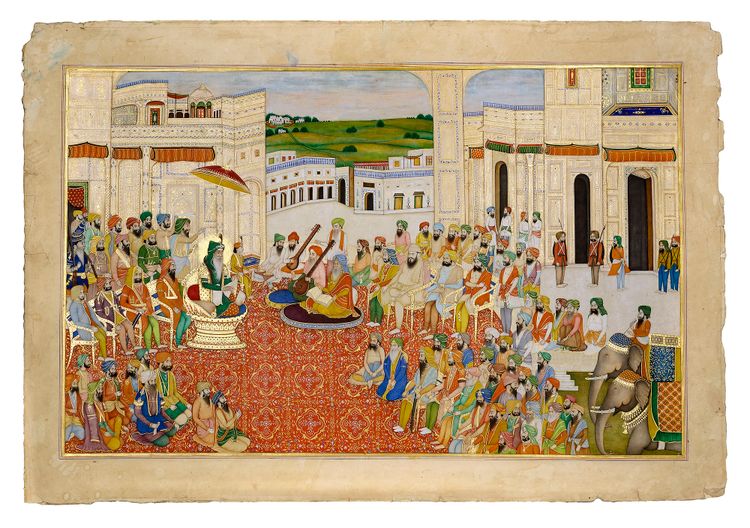MAHARAJA RANJIT SINGH IN DURBAR
Gouache heightened with gold on paper.
Page: 71 by 49 cm.
Painting: 63 by 40 cm.
CATALOGUE NOTE
This painting perhaps by a master artist of the Royal Punjab court depicts the court of the first Sikh ruler, Maharaja Ranjit Singh, within Lahore Fort surrounded by his sons, ministers, generals and attendants. Ranjit Singh, popularly known as Sher-e Punjab (the Lion of Punjab) is depicted in the centre seated on his famous golden throne. Made by Hafiz Muhammad Multani, a leading Muslim goldsmith in his atelier, the throne is now in the Victoria and Albert Museum (acc. no.2518(IS). Members of Ranjit Singh’s family are seated to his right, including his son Kharak Singh who succeeded his father as the second Maharaja of the Sikh Empire, Sher Singh beside Kharak Singh, and Hira Singh as a young boy seated on the left (Ranjit Singh had a great likeness for Hira Singh). Among the Sikh noblemen on his left are Baba Ram Singh Vasti, his spiritual advisor, Raja Gulab Singh, the first Maharaja of Kashmir, Ranjit Singh’s administrator's and other courtiers are seen seated on the chairs below. The centre also depicts a priest accompanied by his companions. Perhaps some religious rituals being performed, before the start of the court proceedings.
The present painting is closely comparable to an illustration in the Toor Collection (D. Toor, In Pursuit of Empire – Treasures from the Toor Collection of Sikh Art, London, 2018, pp. 90-95). The painting in the Toor Collection includes figures of seated noblemen and standing attendants around Maharaja Ranjit Singh, a hilly landscape with an encampment in the background, and an arched doorway with Sikh guards in the lower right section. The surviving fragment of the cover sheet is inscribed in Gurmukhi with the name of the artist, Bishan Singh. The three seated noblemen in the foreground of the Toor illustration have been replaced with a balustrade in our painting which bears a similar Gurmukhi inscription and a vikram samvat date.
The present lot is also strikingly similar to a painting attributable to Bishan Singh formerly in the Edwin Binney 3rd Collection, now in the San Diego Museum of Art, depicting Maharaja Sher Singh and his companions watching a dance performance (acc. no.1990.1348; B.N. Goswamy and C. Smith, Domains of Wonder, San Diego, 2005, fig. no.112, pp.262-3). All three paintings are richly detailed with a similar arrangement of seated and standing figures against a grand architectural setting of arches, jharokhas, and terraces. The bright reds and acidic greens on the clothing and textiles, echoed in the colours of the detailed pietra dura architectural decoration, are in stark contrast to the pale background of the buildings.
A painting depicting a Kashmir shawl weaving workshop, inscribed in Gurmukhi in the lower left corner with the name of Bishan Singh and dated vikram samvat 1931 (circa 1874 AD), similar to the present lot, is in the Musée Guimet, Paris (acc. no.MA 12702). Another painting attributable to Bishan Singh, which depicts ‘Dost Muhammad being received by Sher Singh in Lahore on his way to regain the throne of Kabul’, is in the Kapany Collection (Susan Stronge (ed.), The Arts of the Sikh Kingdoms, London 1999, no.189, pp.166-7). A further example, depicting a nautch being performed for Maharaja Sher Singh, attributable to Bishan Singh, is in the private collection of Prince and Princess Sadruddin Aga Khan (inv.no. M.301; S. Canby, Princes, Poets and Paladins, London, 1998, no.145, p.186).
Similar lots were sold at Sotheby's lot no 44 at the Islamic art sale 31 March 2021 and at Christies on 31 March 2022

